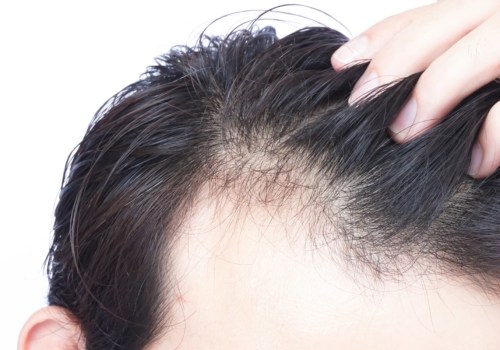After 3 to 4 months, resting hair falls out and new hair begins to grow in its place. It is normal for a little hair to fall out every day as part of this cycle. However, some people may experience excessive (more than normal) hair loss. The vast majority of scalp hair follicles are in the anagen phase, while only 5 to 10 percent are in the telogen phase.
Age, genetics, hormones, thyroid problems, medications, and autoimmune diseases can cause hair loss. Whether, and how quickly, your hair grows back after hair loss will depend on the underlying cause of your hair loss. How long it takes for hair to grow back depends on the underlying cause of hair loss. As we age, some follicles stop producing hair.
This is known as hereditary hair loss, pattern hair loss, or androgenetic alopecia. This type of hair loss is usually permanent, which means that the hair will not grow back. The follicle itself wrinkles and is unable to regrow hair. You may be able to slow the process of hair loss with a prescription oral treatment called finasteride (Propecia) or a topical treatment called minoxidil (Rogaine).
Many men with male-pattern hair loss eventually go bald. Female pattern hair loss can cause hair to thin, but rarely leads to baldness. Alopecia areata is an autoimmune condition in which the immune system mistakenly attacks the hair follicles. Hair usually falls out in small patches on the scalp, but hair loss can occur in other parts of the body, such as the eyebrows, eyelashes, arms, or legs.
Scalp psoriasis can cause temporary hair loss. Scratching your scalp to relieve itching or remove scales can make it much worse. Once you find an effective treatment for your psoriasis and stop scratching your scalp, your hair will begin the growth process. Hair loss due to hormonal changes and imbalances is temporary, although it is difficult to predict when hair will begin to grow again.
Conditions that cause too much thyroid hormone (hyperthyroidism) or too little thyroid hormone (hypothyroidism) can cause hair loss. Hair will normally grow back once the thyroid disorder is successfully treated. Not getting enough iron or zinc in your diet can cause hair loss over time. Correcting the deficiency can provoke hair growth.
Even so, it can take several months for hair to grow back. Chemotherapy is usually used to treat cancer. Chemotherapy is a powerful drug that attacks rapidly sinking cells, such as cancer cells, but it can also attack hair follicles in the scalp and other parts of the body, leading to rapid hair loss. Hair will begin to grow back on its own two to three weeks after chemotherapy is complete.
Hair can grow back like a soft fluff at first. After about a month, real hair will begin to grow back at its normal rate of 6 inches per year. Your new hair may grow back to a different texture or color than before. In rare cases, hair loss from many years of strong chemotherapy can be permanent.
Telogen effluvium occurs when a large number of hair follicles on the scalp enter the telogen (rest) phase of the growth cycle at the same time, but the next growth phase does not begin. Hair starts to fall out all over the scalp, but no new hair grows. It is usually triggered by a medical event, such as childbirth, surgery, or high fever, or by starting or stopping medicines, such as birth control pills. telogen effluvium usually begins approximately three months after the event.
Hair may look thin, but you probably won't go completely bald. Once the triggering event is treated (or recovers from the disease), hair may begin to grow again after six months. However, this type of hair loss can last for years in some people. While taking steps to support hair growth, consider wearing a wig or hair extensions in the meantime.
Hair transplants may be another option for permanent hair loss. But you must do what makes you happy. Hair grows back at a rate of about 6 inches per year. If your hair falls out, see a doctor to be diagnosed with the cause of your hair loss.
If your hair loss is caused by a medical condition, you'll need treatment to treat the entire condition, not just its symptoms, before your hair can recover. Most people see noticeable hair loss two to three months after they have a fever or illness. Handfuls of hair can come out when you shower or brush your hair. This hair loss can last six to nine months before it stops.
Most people see that their hair starts to look normal again and stop falling out. As your body readjusts, excessive shedding stops. Within six to nine months, hair tends to regain its normal fullness. Telogen effluvium is a form of hair loss characterized by thinning hair or an increase in hair loss.
It occurs when more hairs than normal enter the molting phase (telogen) of the hair growth life cycle at the same time. Preventing hair loss is not possible when it is due to illness, aging, heredity, or physical stressors such as injuries. Hair grows on almost all skin surfaces, not on the palms of the hands, soles of the feet, lips, or eyelids. With telogen effluvium, it is common for hair to grow back within 3 to 6 months after the cause has been treated.
Men who have hereditary hair loss tend to develop a receding hairline or bald patch that starts in the center of the scalp. Alopecia areata It develops in otherwise healthy people, this disease that can cause round patches of baldness on the scalp, diffuse hair loss or, in rare cases, complete hair loss. It is important to note that premenopausal women should not take medication for the treatment of hair loss without using contraceptives. If your hair was longer than shoulder length and you have a very short jolt, it may take several years for the hair to grow back to where it was before.
In addition, the stress of the pandemic can cause hair loss in those who have not been infected with the virus. If you suspect that hair loss is caused by more than telogen effluvium from stress or fever, talk to a hair loss expert, a dermatologist. The most important cause of female hair loss is female pattern hair loss (FPHL), which affects approximately one-third of susceptible women, equivalent to about 30 million women in the United States. Hair loss, also known as telogen effluvium, is not on CDC's list of known symptoms of COVID-19, but many have experienced it in the months after diagnosis.
. .





